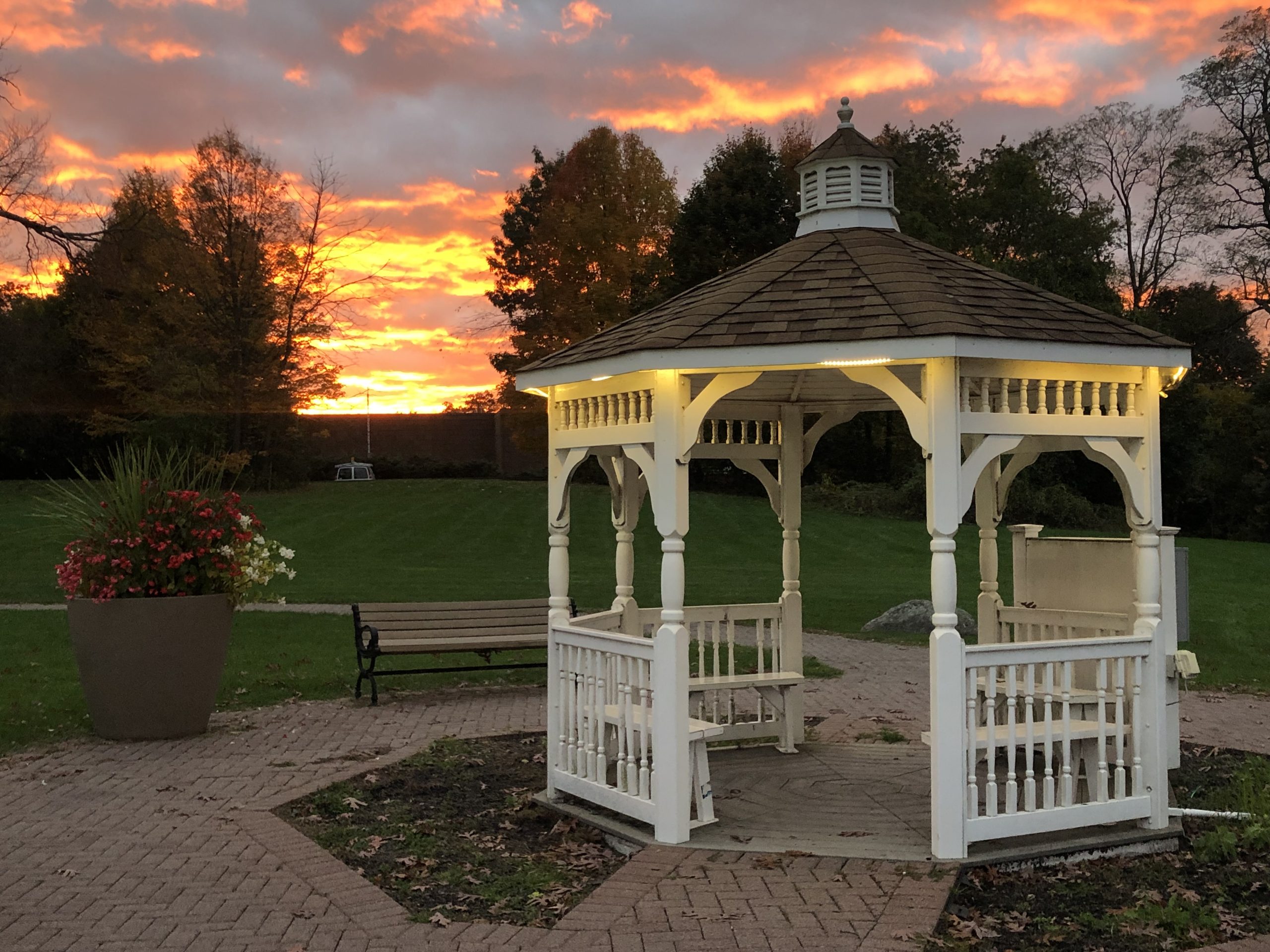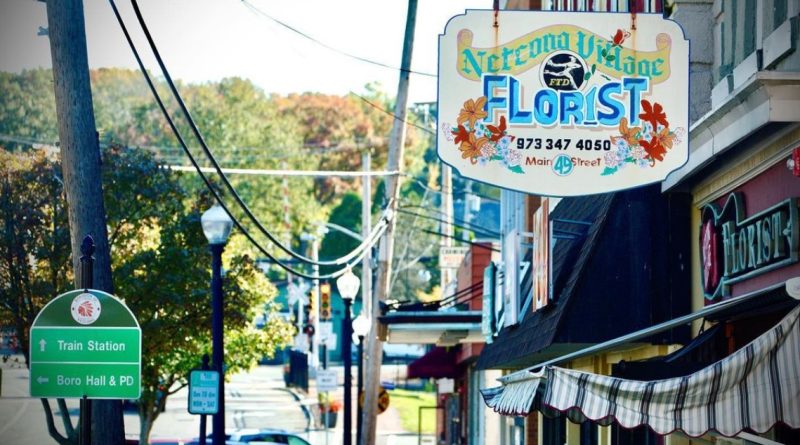Main Street in Netcong | 34 Bank Instagram
It’s evening rush-hour in the Borough of Netcong, Morris County, and a tell-tale clanging heralds the approach of the 6:50pm train from Hoboken. Nearly 20 years ago, this was to be the site of an ambitious transit-oriented revitalization plan. Proposed by the now 100-year-old Regional Plan Association, Netcong Station would have served as the anchor to a public plaza, a greenway connecting to the nearby Furnace Pond, and an entirely new mixed-use neighborhood, replacing old and decaying industrial properties west of Main Street. Today, little has changed beyond some beautification along the main thoroughfare. But a new redevelopment project comprising 126 apartments within a five-minute walk of the rail station was just completed last year, leading some to see signs that plans are finally moving forward.
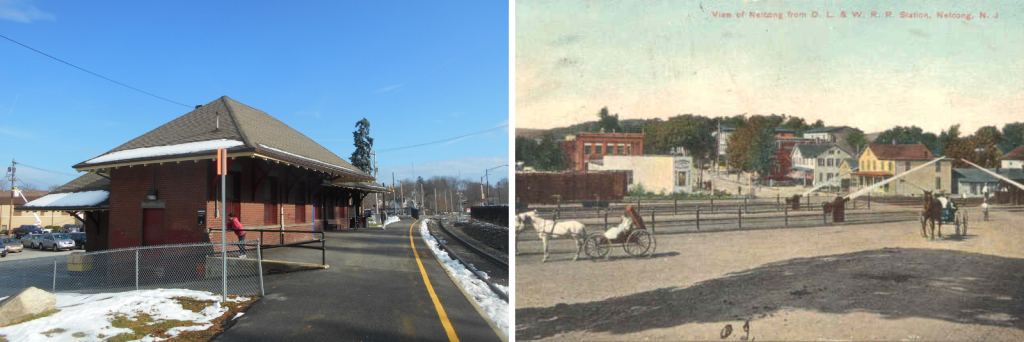
All Roads Lead to Netcong
With a name derived from the Lenape-named Musconetcong River, Netcong has long been a transportation hub and desirable destination. Throughout the 1800s, people and goods moved into and out of the Borough via a major wagon toll road (the Essex-Morris-Sussex Turnpike), the Morris Canal, and two railroad lines. In the 1900s, Lake Musconetcong became a popular attraction for city-dwellers, and the town grew as a hub for commuters after the construction of several major highways, including the nearby intersection of I-80, US Highway 206, and US Highway 46. Today the Borough is served by two NJ TRANSIT lines connecting to Hackettstown and Hoboken, as well as a Lakeland Bus Lines route to the Port Authority Bus Terminal.
Despite all this connectivity, Netcong’s population was a mere 3,375 people in 2020, up by only 154 residents in the last 10 years. Average weekday train boardings have been under 100 since 2017. But the Borough’s relatively affordable housing and naturally walkable, transit-oriented layout still make it an ideal location for people seeking that traditional Main Street atmosphere, with access to New York City as needed.
Transit-Friendly Planning
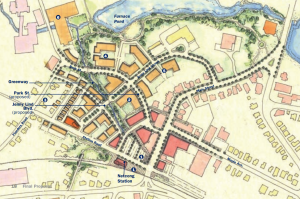
Netcong has looked to build upon its walkability, charm, and accessibility since at least the early 2000s. In 2004, the Regional Plan Association conducted a design study following NJ TRANSIT’s Planning for Transit-Friendly Land Use. The resulting plan, Netcong Station Area Redevelopment Plan, would center on Bank Street, an area dominated by declining industrial properties. The plan aimed to create a new neighborhood, integrated into the existing Main Street fabric and nearby natural resources (including a greenway to nearby Furnace Pond). A redesigned station plaza would anchor the new neighborhood and offer landscaped (and better functioning) parking, more shade, and improved pedestrian areas designed for passive activities like sitting, reading, and socializing.
The plan proposed a neighborhood of small, walkable blocks where two- to three-story, medium-density housing smoothly transitioned to single-family homes to blend with the existing housing stock at the western edge of the Borough. Later phases would have included redeveloping the industrial properties on the north side of Bank Street into two new blocks of mixed-use development, including the adaptive reuse of an old industrial building straddling the Musconetcong River.
The Netcong Station Area Redevelopment Plan was adopted in 2004, along with the designation of the station area as an Area in Need of Redevelopment. The study area comprises approximately ten acres, including about four acres of NJ TRANSIT-owned property.
Waiting for Rosewood Netcong
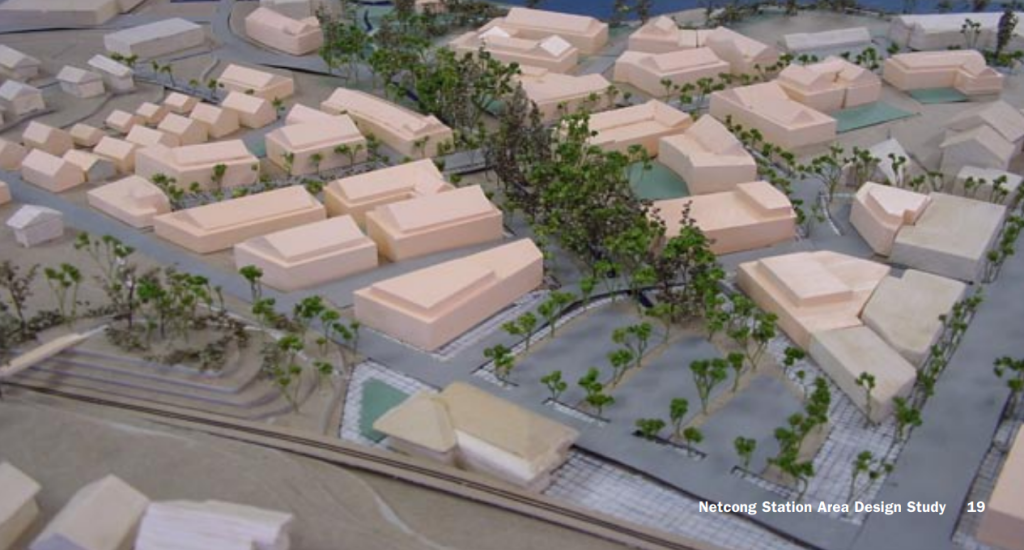
In 2005, Netcong issued an RFP seeking a master developer and development plans for the redevelopment area. The Borough received four proposals, and in 2006 selected Rosewood Netcong, a project jointly offered by Woodmont Properties and Roseland Properties. They planned to build 201 new housing units, plus retail space, a public greenway, and a community center. Their proposal would span 13 acres at Flanders, Bank, and Main Streets and primarily consist of one- and two-bedroom apartments, plus 30 age-restricted units and some townhouses. The plans included 13,200 sq. ft. of ground-floor retail, 7,000 sq. ft. of office space, a transit museum, and a 4,500 sq. ft. community center. The Netcong Borough Council unanimously approved the proposal. The groundbreaking was expected in early 2007, backed by assurances of a streamlined permit process.
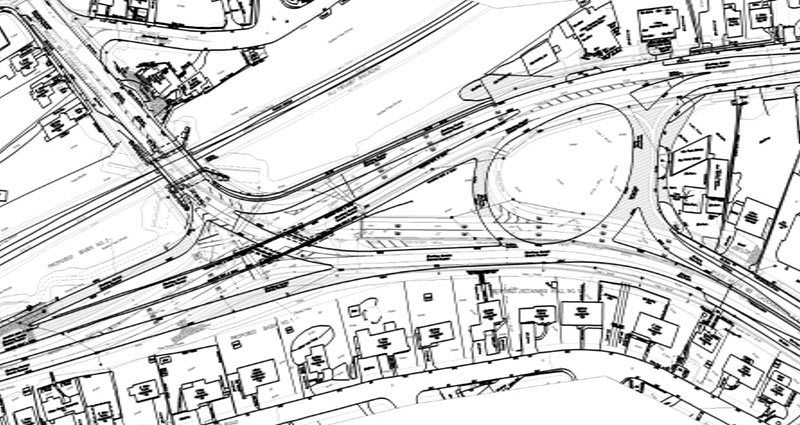
Then, while nearby sidewalk and road safety projects proceeded unabated (as well as the $10.8 million replacement of the Netcong Circle with a signaled intersection), no further news emerged regarding redevelopment proposals. According to Councilman Robert Hathaway, “[Rosewood Netcong] had planned on developing the entire TOD project, but they had to change plans during the Great Recession.”
Once the private developers had pulled out in 2010, the Borough’s Economic Development Commission spent years actively reaching out to developers, but the community was repeatedly turned down. The consensus among private investors was that the project was no longer financially feasible. In addition, it was difficult to build back momentum amidst the critical issues Netcong faced as a small municipality with limited resources. Councilman Hathaway reflected that:
the Borough had to reexamine how best to approach completing the vision, and they realized that what was originally to be Phase 3 had more selling points, so it was amended to be Phase 1, and broken out as a separate parcel. This approach helped spur the project forward and re-attract interest from developers. It also had the added benefit of addressing stormwater infrastructure needs in the area, which would make the whole neighborhood more attractive to further development.
The Return of Multifamily Housing
In rethinking its approach, the Borough’s efforts may have finally paid off. In 2021, a new 4.8-acre residential development was completed at 34 Bank Street, along the edge of Furnace Pond. The complex, containing 126 apartments (with 13 affordable units), comprises four three- and four-story buildings with one-, two-, and three-bedroom apartments. And it isn’t alone: a mere 1,200 ft. away, on the site of the old Pocketbook Factory on Flanders Road between the railroad and Main Street, the Crown Walk is currently under construction and set to open in fall 2022. Only a five-minute walk from the rail station, it promises 80 new apartments (19 one- and 53 two-bedroom), with 10 affordable units (2 one-, 4 two-, and 2 three-bedroom). And Landmark (the owner of 34 Bank) has approached the Netcong Economic Development Commission to discuss redeveloping the parking lot at St. Michael’s Roman Catholic Church (also a five-minute walk from the rail station), proposing 80 new housing units of which 20 would be age-restricted, affordable apartments.
The new development at 34 Bank was a watershed event for Netcong—a signal of the viability of such projects and the ushering in of a wave of walkable, mixed-use development to the area outlined in the original redevelopment plan first offered nearly 20 years ago. The project at 34 Bank lies immediately adjacent to the age-restricted Kings View Apartments, built in 2004—the last multifamily building constructed in the Borough since Landmark’s other property, The Heights, was built in 1973.
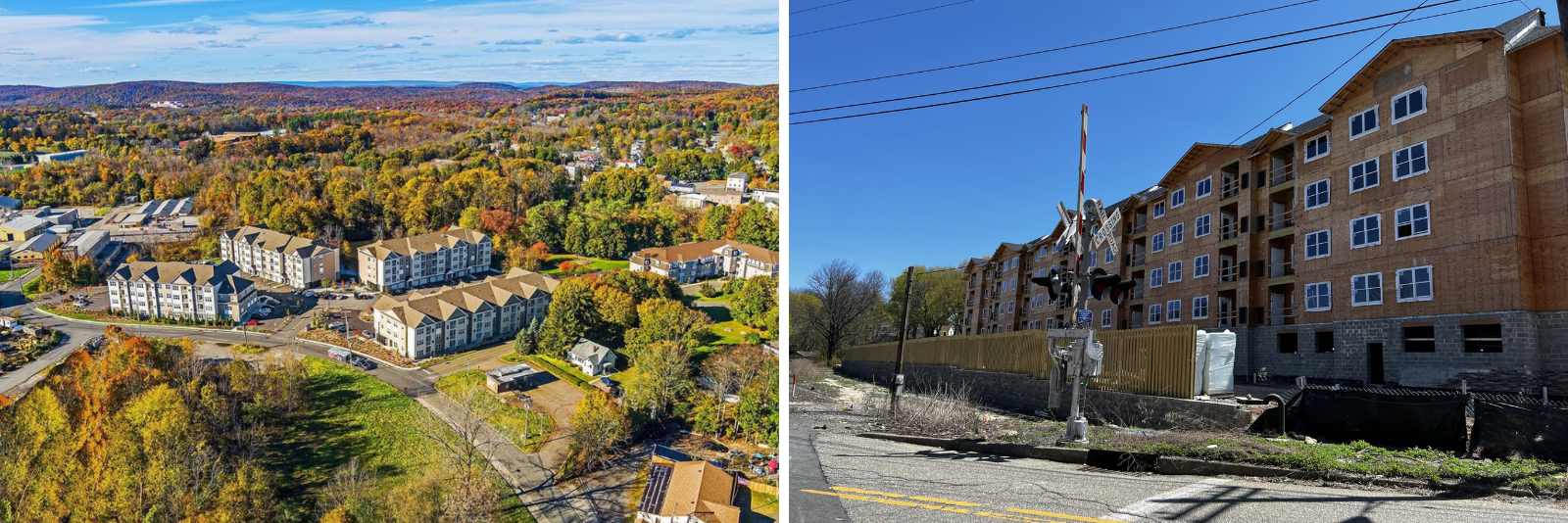
Post-Pandemic Potential

The recent wave of new development in Netcong is well-timed to respond to soaring housing prices. Rising prices reflect both limited housing supply as well as increasing demand from retirees and remote workers newly untethered from their daily commutes who seek out homes further from offices in central locations such as Newark and New York. Netcong (and other rural municipalities in the New York Metro Area) may benefit by offering apartments and townhouses in walkable neighborhoods well-connected to shopping, transit, and outdoor recreation, all accessible without needing to drive. This will become increasingly important as the nation ages and Baby-Boomers find themselves less able to safely operate vehicles and at risk of losing their mobility in more car-dependent areas. As a bonus, these homes use less material, land, and energy to heat or cool than equivalent detached homes, and they can be provided by redeveloping existing vacant in-town lots (rather than paving natural habitats or agricultural land).
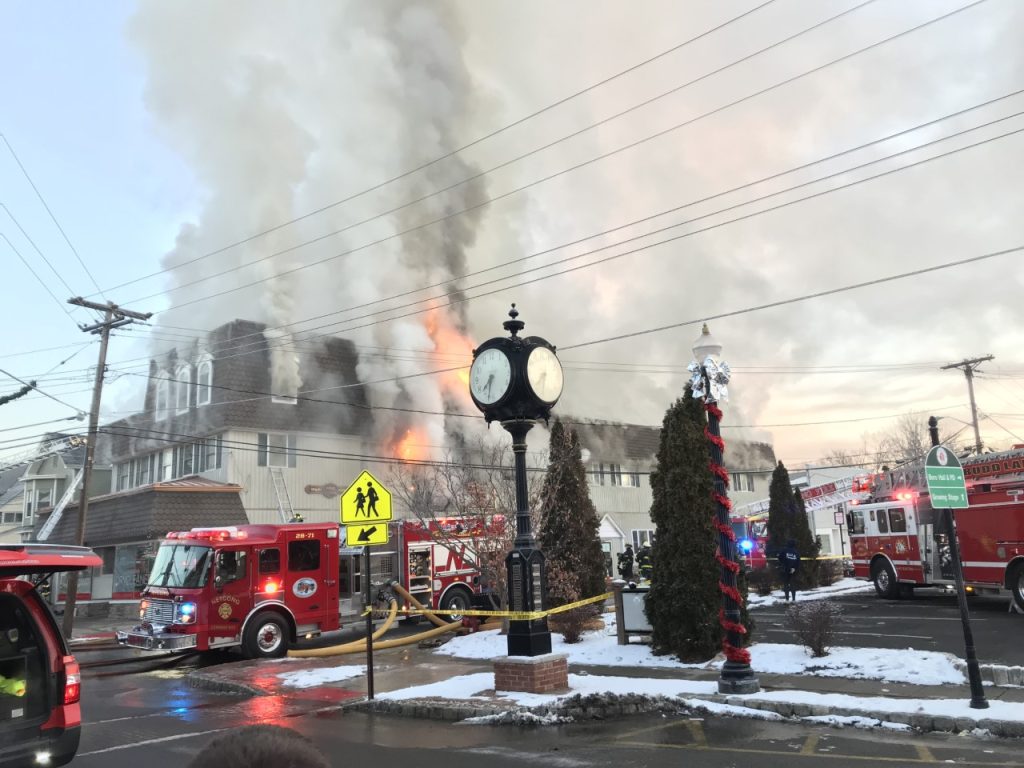
Adding to Netcong’s openness to new development may be the loss of several downtown businesses to fire in 2019. Nine small businesses, in the middle of Netcong’s downtown center, were lost in a three-alarm fire. Despite the tragic loss, this now presents the Borough with a major need and opportunity to bring more walkable, first-floor retail with affordable housing above, in the most amenity-rich part of town.
When discussing transit-oriented development and transit-friendly planning, practitioners and developers often envision urban places or first-ring suburbs. However, places such as Netcong show how transit accessibility and good planning can support each other and be used to preserve and promote dense, walkable locations in the state’s rural towns and villages. These practices are also illustrated in the newest edition of NJ TRANSIT’s Transit Friendly Planning: A Guide for New Jersey Communities (2022), which characterizes rural places by their “small-town, ‘Main Street’ feel, historically having a mix of uses in a compact commercial center surrounded by low-density… or rural landscapes.” The Guide explains how “transit areas can be a catalyst for development, focusing on key destinations and improving walkability in a manner that respects the small-scale context and character of the area”—all of which is exemplified in Netcong.
Though the path has twisted and turned, Netcong has taken the necessary steps to plan for transit-friendly development near its station. The Borough is now looking forward to new investments in accessible housing, shopping and services in places that do not require driving. And with this new development, Netcong expects increased equity, tax revenue, and vibrancy. All in all, Netcong serves as an example of how to harness a community’s transit asset and showcases practices that can be used by similarly situated communities with transit in the state and beyond.
